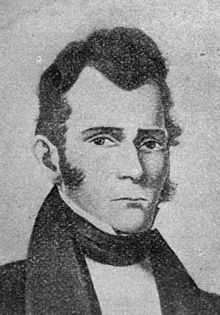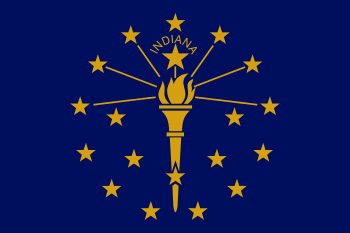Battle of Tipton's Island
| Tipton's Island | |||||||
|---|---|---|---|---|---|---|---|
| Part of the War of 1812 | |||||||
| |||||||
| Belligerents | |||||||
| Kickapoo |
Indiana Rangers | ||||||
| Commanders and leaders | |||||||
| John Tipton | |||||||
| Strength | |||||||
| Unknown | 30 | ||||||
| Casualties and losses | |||||||
|
1 killed 3 drowned in escape Several wounded |
3 settlers killed 2 settlers wounded | ||||||
The Battle of Tipton's Island was an engagement between a Kickapoo war party and Indiana Rangers under command of John Tipton in April 1813, near White River, in Indiana.
In April 1813, during the War of 1812, a Kickapoo war party killed two white settlers eight miles away from Fort Vallonia. The war party continued towards the fort, killing another settler and wounding three more.[1] The Kickapoo then put some distance between themselves and the fort, but were soon pursued by 30 Indiana Rangers under Major John Tipton known as "Corydon's Yellow Jackets".[2]
The Kickapoo crossed the flooded Driftwood River, and thinking they had lost their pursuers, set up camp on an island in the east fork of the White River. One of Tipton's scouts located the trail, however, and the rangers cautiously approached the river. Major Tipton ordered the rangers to maintain absolute silence, and tied one ranger to a tree when he kept talking.[3] The rangers took positions along the bank of the river and opened fire. The Kickapoo were taken by surprise, but returned fire for about half an hour. Few casualties were suffered due to the firing distance across the river and the shelter provided by the wooded island.[4] One Kickapoo was killed and several were wounded, but a few drowned when they deserted the island and tried to swim across the flooded White River.
The Rangers could not pursue the Kickapoo across the river, so they returned to Fort Vallonia. There was a celebration of the Rangers' victory, but as details of the skirmish became known, it was determined to be a small engagement against a war party that managed to escape. "Tipton's Island" became a term of ridicule.[5]
See also
Notes
- Allison, Harold (1986). The Tragic Saga of the Indiana Indians. Paducah: Turner Publishing Company. ISBN 0-938021-07-9.
- Pershing, Marvin W (190?). Life of General John Tipton and Early Indiana History. Tipton literary and Suffrage Club. Check date values in:
|date=(help) Also on archive.org
| |||||||||||||||||||||



